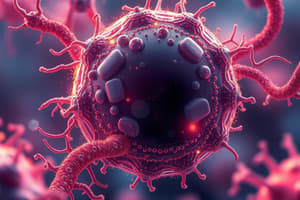Podcast
Questions and Answers
Quelle est la fonction principale de la paroi cellulaire chez les bactéries?
Quelle est la fonction principale de la paroi cellulaire chez les bactéries?
- Maintenir la forme et la structure de la cellule (correct)
- Fournir de l'énergie à la cellule
- Réguler la croissance cellulaire
- Protéger la cellule contre les agents pathogènes
Quel est le composant principal du cytoplasme?
Quel est le composant principal du cytoplasme?
- Composés organiques variés (correct)
- Sels
- Sucres
- Eau
Quel est le rôle de la membrane plasmique?
Quel est le rôle de la membrane plasmique?
- De synthétiser des protéines
- De stocker l'ADN
- De réguler le flux de matières en entrée et en sortie de la cellule (correct)
- De fournir de l'énergie à la cellule
Quel est le site de la synthèse des protéines dans la cellule?
Quel est le site de la synthèse des protéines dans la cellule?
Quels sont les composants principaux des ribosomes?
Quels sont les composants principaux des ribosomes?
Quel est le rôle de la membrane plasmique en ce qui concerne la homeostasie cellulaire?
Quel est le rôle de la membrane plasmique en ce qui concerne la homeostasie cellulaire?
Flashcards are hidden until you start studying
Study Notes
Cell Wall
- Present in most bacteria, but not in some species like Mycoplasma
- Composed of peptidoglycan (also known as murein), a thick layer of polysaccharide chains cross-linked by short peptides
- Provides structural support and maintains cell shape
- Helps to maintain osmotic balance and prevents cell lysis
- Can be Gram-positive or Gram-negative, depending on the type of peptidoglycan and the presence of additional layers
Cytoplasm
- A gel-like substance inside the cell membrane
- Composed of water, salts, sugars, and various organic compounds
- Contains the cell's genetic material (DNA), ribosomes, and various metabolic pathways
- Site of many cellular activities, such as glycolysis, protein synthesis, and cell division
- Can be differentiated into various regions, such as the nucleoid (where DNA is located) and the cytosol (where metabolic reactions occur)
Plasma Membrane
- A thin, semi-permeable membrane that surrounds the cell and regulates the flow of materials in and out
- Composed of a phospholipid bilayer with embedded proteins
- Maintains cellular homeostasis by controlling the movement of ions, nutrients, and waste products
- Involved in various cellular processes, such as cell signaling, transport, and secretion
- Can be selectively permeable to allow certain substances to pass through while keeping others out
Ribosomes
- Small, complex organelles found throughout the cytoplasm
- Composed of rRNA and proteins
- Site of protein synthesis, where mRNA is translated into amino acid chains
- Can be free in the cytoplasm or attached to the plasma membrane
- Found in large numbers in cells that are actively synthesizing proteins, such as during rapid growth or division
Studying That Suits You
Use AI to generate personalized quizzes and flashcards to suit your learning preferences.




